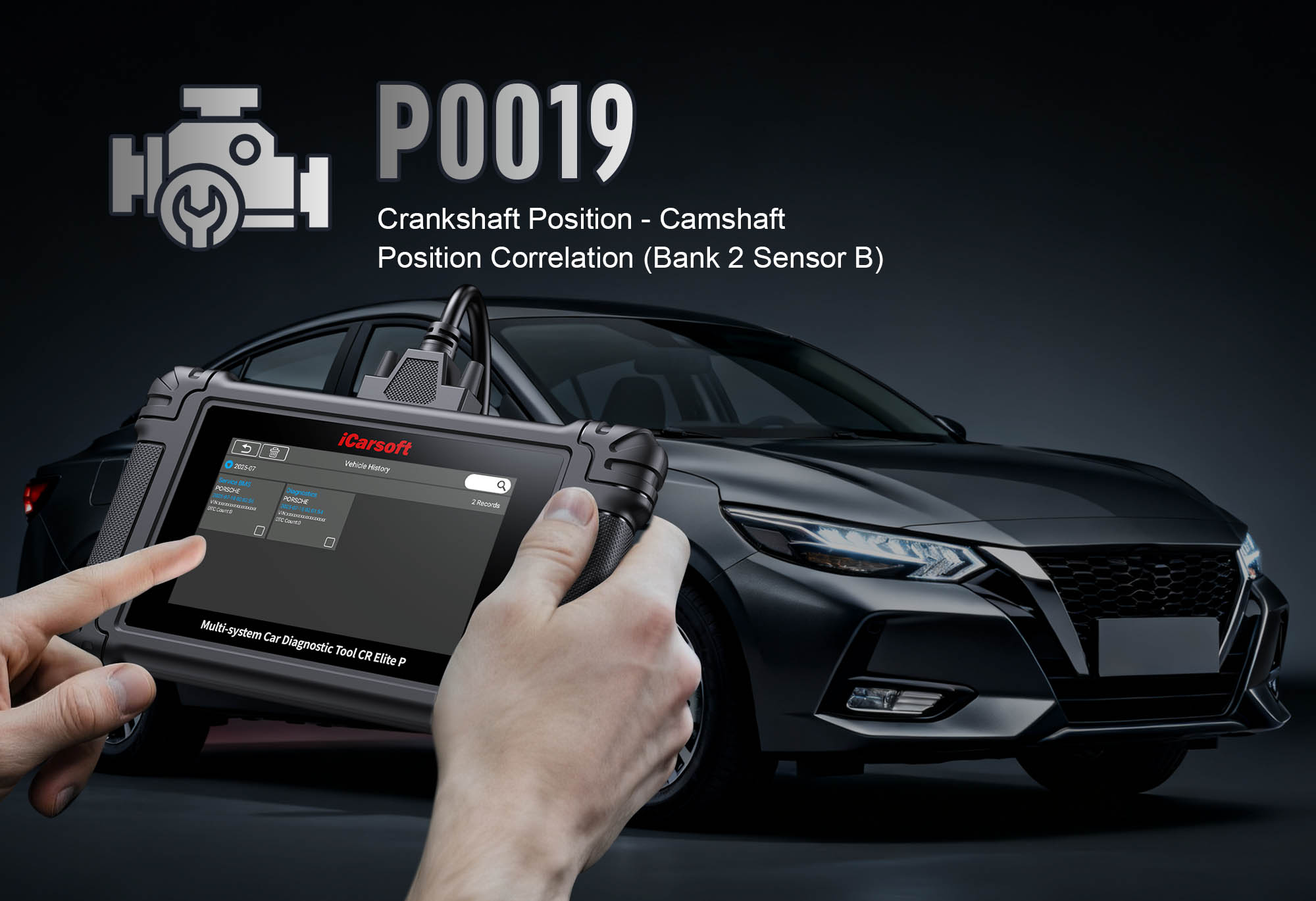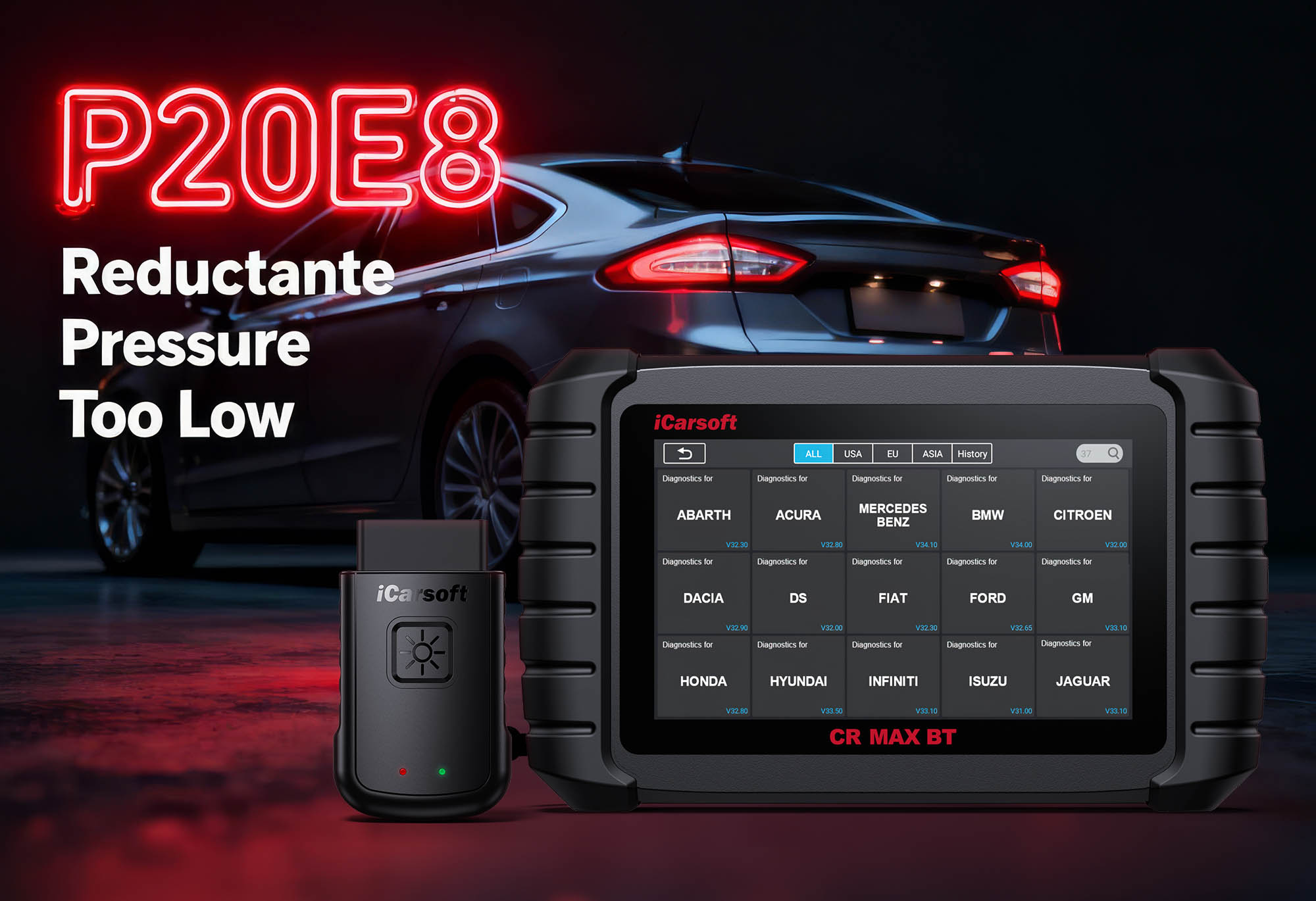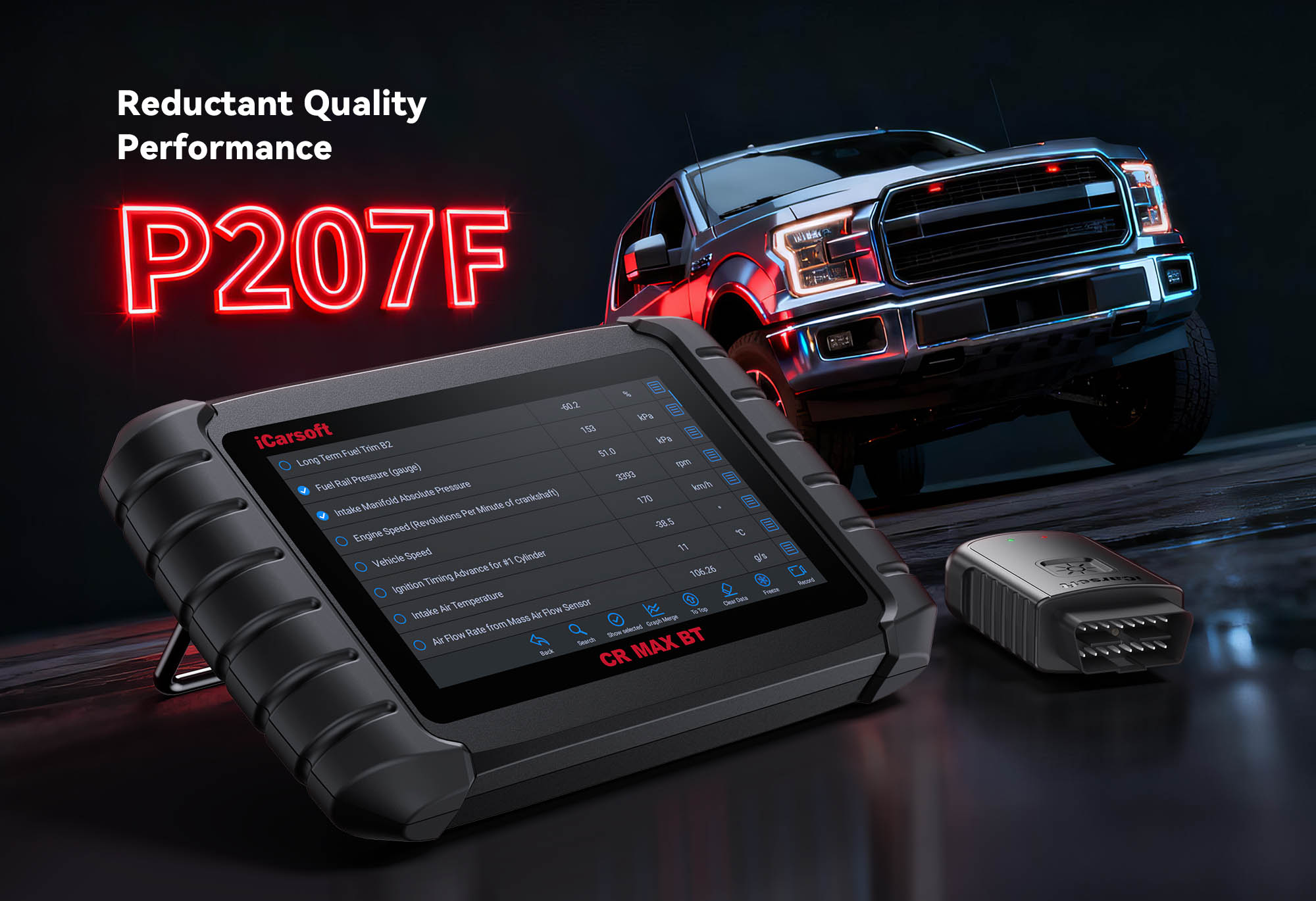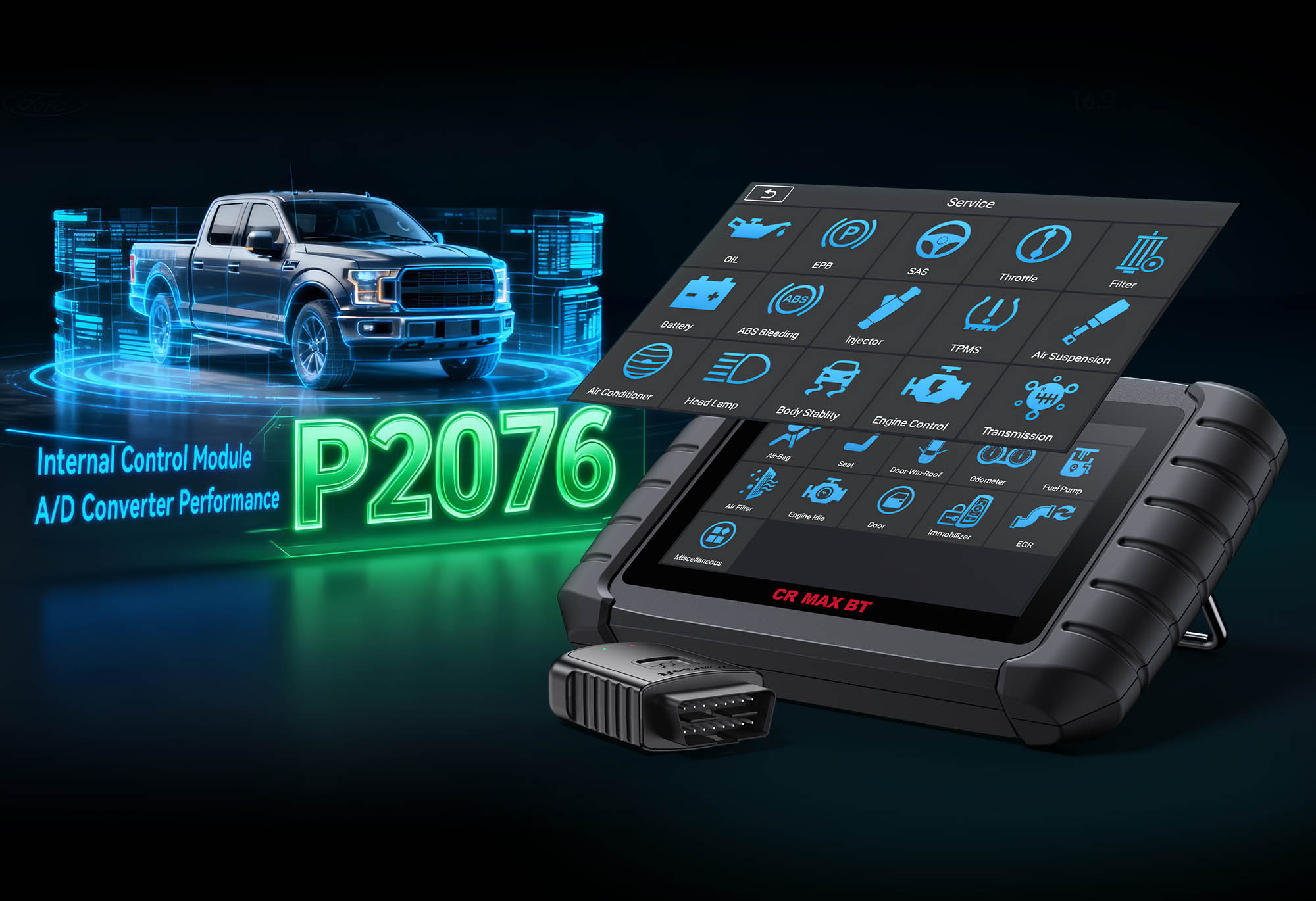Diagnose & Clear P0019 with iCarsoft CR Elite P: Fix Exhaust Camshaft Position System Performance (Bank 2)
When your check engine light turns on, you hear a persistent rattle from the engine bay, or notice a sharp drop in acceleration, a diagnostic scan will likely return P0019. This OBD-II code stands for "Exhaust Camshaft Position System Performance or Response – Bank 2"—the Engine Control Module (ECM) detects a mismatch between the requested and actual timing of Bank 2’s exhaust camshaft. Modern Variable Valve Timing (VVT) systems (e.g., Toyota VVT-i, Ford Ti-VCT) rely on precise cam timing for efficiency and power; a failure here disrupts combustion, leading to rough running, higher emissions, and potential long-term engine damage.
Basic scanners only flag "camshaft timing error" but can’t track Bank 2-specific VVT solenoid operation, measure VVT circuit oil pressure, or compare cam/crank signals side-by-side. The iCarsoft CR Elite P solves this with bank-specific diagnostics, live timing tracking, and oil pressure monitoring. Below is a step-by-step guide to diagnosing and fixing P0019 accurately.
Understanding P0019: Symptoms & Common Causes
Bank 2’s VVT system uses oil pressure (controlled by a dedicated solenoid) to adjust the exhaust camshaft via a cam phaser. P0019 triggers when the ECM commands the cam to advance/retard, but the actual timing (measured by Bank 2’s exhaust Camshaft Position Sensor, CMP) is outside the acceptable range (±2–3 degrees). Symptoms worsen as timing misalignment disrupts valve operation:
Key Symptoms of P0019
-
Check Engine Light (CEL): Illuminates steadily; many vehicles display a "VVT System Warning" on the dashboard.
-
Engine Rattling/Knocking: Most noticeable at idle/low RPM (800–1,200 RPM)—caused by a stuck/worn cam phaser failing to sync with the crankshaft.
-
Sluggish Acceleration: Misaligned valves reduce Bank 2 airflow, leading to delayed power (e.g., hesitation when merging/passing).
-
Increased Fuel Consumption: Inefficient combustion drops mileage by 10–25%.
-
Rough Idle: Engine shakes or fluctuates between 500–1,000 RPM at stops—Bank 2 cylinders get an imbalanced air-fuel mixture.
-
Failed Emissions Tests: Incorrect timing spikes hydrocarbon (HC) and nitrogen oxide (NOx) levels, guaranteeing a fail.
Common Causes of P0019
|
Cause
|
Description
|
|
Faulty Bank 2 Exhaust VVT Solenoid
|
Electrical (broken coil) or mechanical (stuck valve) failure stops the solenoid from controlling oil flow to Bank 2’s cam phaser.
|
|
Low/Contaminated Engine Oil
|
Low oil reduces VVT pressure; dirty oil (sludge/debris) clogs the Bank 2 solenoid/phaser, blocking oil flow.
|
|
Worn Bank 2 Exhaust Cam Phaser
|
Internal wear (damaged vanes/seals) prevents the phaser from responding to oil pressure, leaving timing stuck.
|
|
Clogged Bank 2 VVT Oil Passages
|
Sludge buildup in oil passages (to Bank 2’s VVT system) restricts flow, limiting timing adjustment.
|
|
Faulty Bank 2 Exhaust CMP Sensor
|
A bad CMP sensor sends incorrect timing data to the ECM, triggering false P0019.
|
|
Oil Pressure Sensor Failure
|
A faulty sensor misreports pressure to the ECM, causing it to unnecessarily restrict Bank 2 VVT oil flow.
|
Why iCarsoft CR Elite P Excels at Diagnosing P0019
The CR Elite P outperforms basic tools with Bank 2-specific VVT features critical for resolving P0019:
Bank-Specific Cam Timing Tracking
Compares real-time Bank 2 exhaust CMP and crankshaft (CKP) signals—verifies timing alignment with ECM commands (0–30° advance/retard). Side-by-side Bank 1 comparison isolates Bank 2 issues.
Bank 2 VVT Solenoid Bi-Directional Tests
Sends direct commands to Bank 2’s exhaust VVT solenoid to open/close—rules out ECM vs. solenoid faults.
Bank 2 VVT Circuit Oil Pressure Monitoring
Tracks oil pressure in Bank 2’s VVT system (20–60 psi at idle) to confirm if low pressure causes timing delays.
AutoVIN Identify
Automatically retrieves engine type (e.g., Ford 5.0L Coyote) and VVT design—ensures access to Bank 2 solenoid specs (voltage, oil flow).
Global VVT Coverage
Works with 500+ gasoline/hybrid models (Ford, Chevrolet, Toyota) and all major VVT tech (VVT-i, Ti-VCT, VTEC).
Bank 2 CMP Sensor Validation
Tests Bank 2’s exhaust CMP sensor signal strength/accuracy—confirms if it sends valid timing data to the ECM.
Oil Temperature Monitoring
Tracks oil temp (180–220°F/82–104°C)—cold/overheated oil disrupts Bank 2 VVT oil flow.
Step-by-Step: Diagnose P0019 with iCarsoft CR Elite P
-
1. Initial Engine Oil Check (Most Critical First Step)
Low/dirty oil is the #1 cause of P0019—start here to avoid unnecessary repairs:
-
Check Oil Level: Park on level ground, turn off engine (wait 5 mins for oil to drain). Locate the yellow-handled dipstick (or use Component Location > Engine > Oil Dipstick). Oil must be between "Min" and "Max" marks. Add manufacturer-recommended oil (e.g., 5W-30 full-synthetic for Ford EcoBoost) if low (check the CR Elite P’s Oil Guide for specs).
-
Check Oil Condition: Healthy oil is amber/translucent. Dark brown/black or gritty (sludge) oil = contaminated—do an oil change immediately (use full-synthetic oil for VVT systems).
-
2. Connect CR Elite P & Confirm P0019
-
Plug the tool into the OBD-II port. Power on and select AutoVIN Identify—it detects your engine type, VVT system, and ECM software.
-
Navigate to Engine > Fault Codes > Read Codes to confirm P0019. Tap Code Details for vehicle-specific insights (e.g., "Ford F-150 5.0L: Requested Timing +12°, Actual +2°; Check Bank 2 VVT Solenoid/Oil Pressure").
-
Resolve related codes (e.g., P0018 for Bank 2 intake cam, P0346 for Bank 2 CMP) first—they often stem from P0019.
-
3. Monitor Live Cam Timing & Oil Pressure
Real-time data reveals Bank 2 timing alignment and pressure sufficiency:
-
Start the engine and idle 10–15 mins (warm to >80°C coolant, >180°F oil temp).
-
Navigate to Engine > Live Data > VVT/Camshaft Timing and monitor 4 key parameters:
-
Bank 2 Requested vs. Actual Timing: Should match within 2–3°; gap >5° = root cause (stuck solenoid/low pressure).
-
Bank 2 vs. Bank 1 Comparison: Bank 1 normal + Bank 2 off = isolated Bank 2 issue; both off = system-wide (low pressure/oil pump).
-
Bank 2 VVT Solenoid Duty Cycle: Should change with acceleration (0–100%); fixed 0%/100% = faulty solenoid.
-
Engine Oil Pressure: 20–60 psi at idle, 40–80 psi at 2,000 RPM; <20 psi = insufficient Bank 2 VVT flow.
-
4. Test Bank 2 Exhaust VVT Solenoid
-
Locate the Solenoid: Use Component Location > Engine > VVT System > Bank 2 Exhaust Solenoid—mounted on Bank 2’s cylinder head (near the exhaust camshaft). Note: Bank 2 is usually the bank farthest from the engine front (e.g., passenger side on V6/V8).
-
Bi-Directional Test: Turn off engine, set ignition to "ON." Navigate to Special Functions > Engine > VVT Solenoid Control > Bank 2 Exhaust. Command "50% Duty Cycle" (moderate flow) and "100% Duty Cycle" (max flow)—listen for a "click" and check oil flow (if accessible):
-
Good Solenoid: Clicks and adjusts flow as commanded.
-
Faulty Solenoid: No click/no flow = replace (use Part Lookup for OEM parts, e.g., Motorcraft CM-5E527 for Ford Bank 2).
-
Clean if Clogged: If electrically functional but clogged, remove the solenoid, spray with brake cleaner (avoid electrical connector), and clear debris with a small brush. Reinstall and retest.
-
5. Test Bank 2 Exhaust CMP Sensor
A bad CMP sensor sends false timing data—verify its accuracy:
-
Navigate to Engine > Live Data > Camshaft Sensors > Bank 2 Exhaust CMP. Monitor signal frequency (Hz) at idle/acceleration—should increase smoothly (50 Hz idle, 200 Hz at 2,000 RPM). Intermittent/dropping frequency = faulty sensor.
-
Circuit Test: Turn off engine, disconnect Bank 2 CMP connector. Use the CR Elite P’s multimeter to check:
-
Power: 5V/12V at power pin (ignition "ON"); 0V = blown fuse/broken wire (check Fuse Guide for CMP fuse).
-
Signal Wire Resistance: <5 ohms to ECM (via Wiring Diagram); >10 ohms = damaged wire.
-
Replace with an OEM sensor if faulty—aftermarket sensors may not match ECM timing requirements for VVT systems.
-
6. Inspect Bank 2 VVT Oil Passages & Cam Phaser
If solenoid and CMP sensor work, check for restricted flow or worn phaser:
-
Oil Passages: Locate passages to Bank 2’s VVT solenoid (via Component Location). Remove the solenoid and clear sludge with a small wire brush/compressed air (avoid scratching passage walls).
-
Cam Phaser Check: Accessing the phaser requires timing cover removal (advanced repair). If Bank 2 timing is stuck (no adjustment) despite good solenoid/pressure, the phaser is worn—consult a mechanic (use Service Guide for DIY steps).
-
7. Repair & Clear P0019
Fix the root cause based on diagnostics:
-
Low/Contaminated Oil: Add oil or do an oil change (full-synthetic + high-quality filter, e.g., Mobil 1 Extended Performance).
-
Faulty Bank 2 VVT Solenoid: Replace with OEM part (cost: $50–$150); torque to 8–10 Nm.
-
Clogged Bank 2 Passages: Clean passages and flush engine with sludge remover (follow Engine Flush Guide).
-
Bad Bank 2 CMP Sensor: Replace with OEM part (cost: $80–$200) and recheck timing.
-
Worn Cam Phaser: Replace (professional help recommended; cost: $300–$800 + labor) and refresh VVT with new oil.
Clear the code: Navigate to Engine > Fault Codes > Clear Codes and confirm P0019 is deleted.
-
8. Reset VVT Adaptations & Validate Repair
-
Reset Adaptations: The ECM learns "bad" timing patterns—navigate to Special Functions > Engine > VVT Adaptation Reset and follow prompts (e.g., "Idle 2 mins, accelerate to 3,000 RPM for 10 secs").
-
Test Drive: Drive 20–30 mins (idle, acceleration, highway) — check for no rattling, restored power, and smooth operation.
-
Post-Repair Data: Confirm Bank 2 timing matches (±2–3°) and oil pressure is normal (via live data).
-
I/M Readiness Test: Run under OBDII Functions to confirm the VVT system passes emissions (critical for registration).
Preventing P0019 Recurrence
Use the CR Elite P to maintain Bank 2 VVT system health:
-
Oil Maintenance: Set Service Reminder for oil changes every 5,000–7,500 miles (manufacturer-recommended) — use full-synthetic oil.
-
Bank 2 VVT Solenoid Checks: Test every 30,000 miles to catch early sticking.
-
Oil Filter Replacement: Use OEM/high-quality filters (e.g., Fram Ultra) to prevent debris in Bank 2 VVT passages.
-
Bank 2 CMP Sensor Checks: Test every 60,000 miles; replace every 100,000 miles to avoid false timing data.
Conclusion
P0019’s Bank 2 timing fault disrupts engine performance, but the iCarsoft CR Elite P simplifies diagnosis with Bank 2-specific VVT tools—no more guessing between system-wide or bank-isolated issues. Whether you’re changing oil, replacing a solenoid, or cleaning passages, this tool ensures you target the root cause, saving time and money on unnecessary repairs.
For DIYers and pros alike, the CR Elite P’s bank-specific expertise, global coverage, and intuitive interface make it the best tool for resolving P0019. Restore proper Bank 2 cam timing, regain power, and keep your engine efficient—all with one professional-grade diagnostic tool.
FAQs About P0019
Q: How do I confirm which bank is Bank 2?
A: Use the CR Elite P’s Component Location > Engine > Cylinder Banks—Bank 2 is the cylinder bank without the #1 cylinder (usually the one farthest from the engine front, e.g., passenger side on most V6/V8 engines).
Q: Can I keep driving with P0014?
A: Short trips (to a repair shop) are safe, but prolonged driving risks cam phaser damage or reduced engine life. If you hear rattling, fix P0019 within 50 miles to avoid worsening issues.
Q: Why does P0019 come back after solenoid replacement?
A: The solenoid replacement only fixes one cause—if P0019 returns, the issue is likely clogged Bank 2 oil passages, a bad CMP sensor, or a worn cam phaser. Use the CR Elite P’s live timing data to retest.
Q: How much does it cost to fix P0019?
A: Costs range from $30–$100 (oil change), $80–$300 (Bank 2 VVT solenoid + labor), to $500–$1,500 (cam phaser replacement + labor). The CR Elite P saves by avoiding unnecessary phaser swaps.





